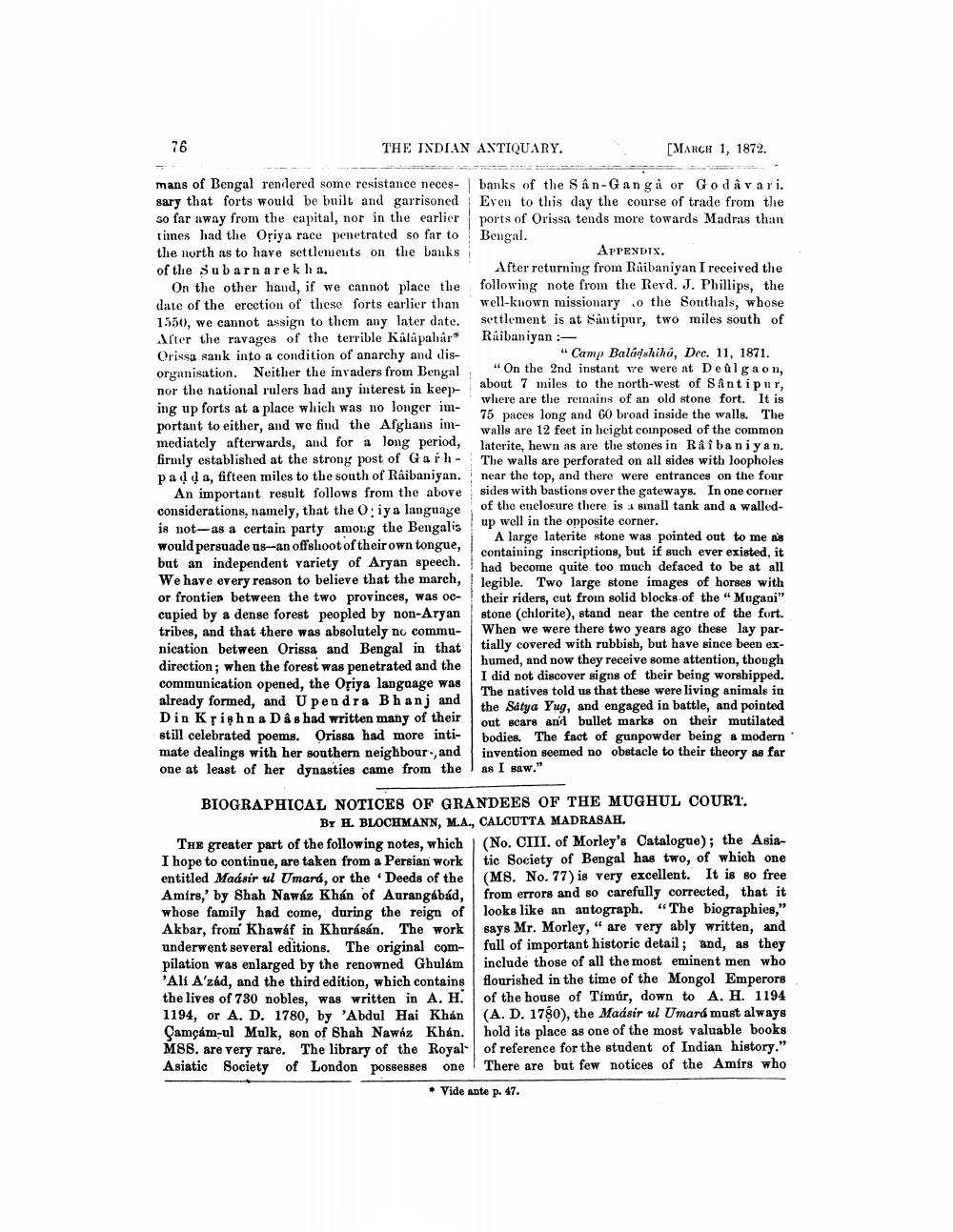________________
76
THE INDIAN ANTIQUARY.
[MARCH 1, 1872.
mans of Bengal rendered some resistance neces- sary that forts would be built and garrisoned so far away from the capital, nor in the earlier times had the Oriya race penetrated so far to the north as to have settlements on the banks of the subarnarekha.
On the other hand, if we cannot place the date of the erection of these forts earlier than 1550, we cannot assign to them any later date. After the ravages of the terrible Kâlâpahar Orissa sank into a condition of anarchy and disorganisation. Neither the invaders from Bengal nor the national rulers had any interest in keeping up forts at a place which was no longer important to either, and we find the Afghans immediately afterwards, and for a long period, firmly established at the strong post of Garh - pad 4 a, fifteen miles to the south of Raibaniyan.
An important result follows from the above considerations, namely, that the 0:iy a language is not--as a certain party among the Bengalis would persuade us--an offshoot of their own tongue, but an independent variety of Aryan speech. We have every reason to believe that the march, or frontier between the two provinces, was occupied by a dense forest peopled by non-Aryan tribes, and that there was absolutely no communication between Orissa and Bengal in that direction; when the forest was penetrated and the communication opened, the Oriya langaage was already formed, and Upendra Bhanj and Din Krishna Das had written many of their still celebrated poems. Orissa had more intimate dealings with her southern neighbour, and one at least of her dynasties came from the
banks of the San-Ganga or Godavari. Even to this day the course of trade from the ports of Orissa tends more towards Madras than Bengal.
Appendix. After returning from Raibaniyan I received the following note from the Revd. J. Phillips, the well-known missionary .o the Southals, whose settlement is at Santipur, two miles south of Raibaniyan
* Camp Baládshiha, Dec. 11, 1871. “On the 2nd instant we were at Dealga on, about 7 miles to the north-west of Santipur, where are the remains of an old stone fort. It is 75 paces long and 60 broad inside the walls. The walls are 12 feet in height composed of the common laterite, hewn as are the stones in Raiba niyan. The walls are perforated on all sides with loopholes near the top, and there were entrances on the four sides with bastions over the gateways. In one corner of the enclosure there is . Binall tank and a walledup well in the opposite corner.
A large laterite stone was pointed out to me a's containing inscriptions, but if such ever existed, it had become quite too much defaced to be at all legible. Two large stone images of horses with their riders, cut froin solid blocks of the "Mugani" stone (chlorite), stand near the centre of the fort. When we were there two years ago these lay partially covered with rubbish, but have since been exhumed, and now they receive some attention, though I did not discover signs of their being worshipped, The natives told us that these were living animals in the Satya Yug, and engaged in battle, and pointed out scars and bullet marks on their mutilated bodies. The fact of gunpowder being a modern invention seemed no obstacle to their theory as far as I saw."
BIOGRAPHICAL NOTICES OF GRANDEES OF THE MUGHUL COURT.
BY H. BLOCHMANN, M.A., CALCUTTA MADRASAH. The greater part of the following notes, which (No. CIII. of Morley's Catalogue); the AsiaI hope to continue, are taken from a Persian work tic Society of Bengal has two, of which one entitled Maásir ul Umard, or the Deeds of the (MS. No. 77) is very excellent. It is so free Amirs,' by Shah Nawáz Khán of Aurangabad, from errors and so carefully corrected, that it whose family had come, during the reign of looks like an antograph. "The biographies," Akbar, from Khawáf in Khurásán. The work says Mr. Morley, " are very ably written, and underwent several editions. The original com- full of important historic detail; and, as they pilation was enlarged by the renowned Ghulam include those of all the most eminent men who 'Ali A'zád, and the third edition, which contains flourished in the time of the Mongol Emperors the lives of 780 nobles, was written in A. H. of the house of Timur, down to A. H. 1194 1194, or A. D. 1780, by 'Abdul Hai Khán (A. D. 17$0), the Maásir ul Umará must always Çamçám-ul Mulk, son of Shah Nawaz Khán. hold its place as one of the most valuable books M88. are very rare. The library of the Royal of reference for the student of Indian history." Asiatic Society of London possesses one There are but few notices of the Amirs who
• Vide ante p. 47.




